Heathkit Ham Radio
Brief History
When Edward Bayard Heath founded the Heath Aeroplane Company during the early 1900's, little did he realize what would eventually evolve from his small "airplane trading post" as it was commonly called. Before he died, Mr. Heath was able to see the fruition of his early dreams. In 1926, he produced a light aircraft in kit form—the famous Heath "Parasol." For years this aircraft was a favorite in the flying fraternity. Mr. Heath was killed during a test flight in 1931, marking a tragic end to a brilliant career. From that point through World War II, the Heath Company remained in the aircraft and replacement parts business.
It wasn't until shortly after World War II, that the character of the Heath Company changed. It was then that an ambitious engineer named Howard Anthony, who had purchased the Heath Company in 1935, took a calculated gamble. He bought a large stock of surplus wartime electronic parts and designed and "mail order marketed" an oscilloscope kit for $39.50.
Howard Anthony based the success of his idea on the premise that anyone, regardless of technical knowledge or skills, could assemble a kit and save up to 50% over comparable factory-built models. All that would be required were a few simple hand tools and some spare time.
Orders poured in for the oscilloscope kit and the foundation for the Heath Company was established. Mr. Anthony expanded his test instrument line and soon added amateur radio and hi-fi component kits.
The key to the kit-builder's, and consequently Mr. Anthony's, success, were the instruction manuals. They contained simple, non-technical instructions and large "exploded" diagrams that take the builder through each and every step, showing exactly what to do and how to do it. In my restoration of Heathkit products I would have been lost without the fantastic documentation
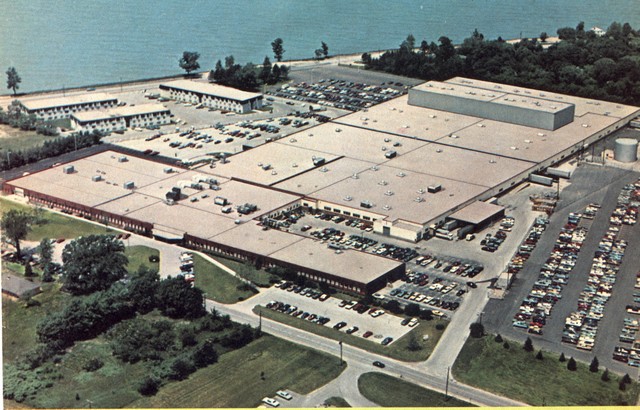 Tragedy struck
yet again in 1954 when Howard Anthony was also
killed in an plane crash. Daystrom, Inc. then acquired the Heath
Company and in 1962 Daystrom itself was purchased by Schlumberger Limited, a
leader in the development of electronic techniques for oil exploration.
Tragedy struck
yet again in 1954 when Howard Anthony was also
killed in an plane crash. Daystrom, Inc. then acquired the Heath
Company and in 1962 Daystrom itself was purchased by Schlumberger Limited, a
leader in the development of electronic techniques for oil exploration.
Through the 60s and into the 70s Heath added a huge number of kits to its product line. Its plant in the USA was particularly impressive and whatever your interest, you could find a kit to match it. The Ham Radio line became world famous and many of its products are still on the air, the US in particular has an avid collector community. Sadly the boom time for these kits came to and end in the 1980s when it was much cheaper to buy something ready made.
September 2017 SB102
Took delivery of this radio from a ham in Sussex, no information on operation (or lack of it!). As with every other refurbishment the first assessment normally reveals the likely work required. The radio had a been the victim of my dear friend 'Mr Radio Bodger' (I am getting to know him very well). For some inexplicable reason the 11 pin power socket had been rewired - including the mains switch connections (which come from the HP23 PSU). The multiway accessory plug had also been removed with various tag strips added under the radio...and why put the S Meter 'zero' on the front panel?. The weirdest one was that Mr Bodger had rewired and/or replaced the USB/LSB switch and got it wrong - rendering LSB inoperable. The cut wires were the give away, and after comparing it with an HW101 it was obvious he had got the contacts on the switch mixed up - it can't have ever worked. After a day of putting things right the radio came to life but with poor RX audio. It didn't take long to find the many resistors that had gone high in value. As with the HW101s - changing resistors on the RF board requires removal of some of the bandswitch wafers - which is a pain - and I have not worked up enthusiasm the for this ..yet!. Loads of contacts on 40 and 80m. Rusty case repainted with my normal process
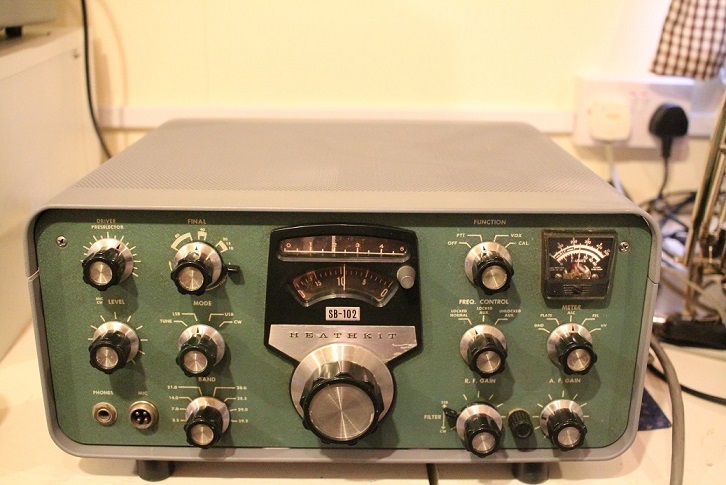
Later in 2018 I managed to add a couple of items that go to make up part of the 'SB Line'. The SB610 monitor scope came from a local ham who didn't collect Heathkit, and the SB600 was a gift from a chap clearing his house. The speaker came with the HP23 PSU and an unbuilt upgrade kit. Looks impressive and works well to !
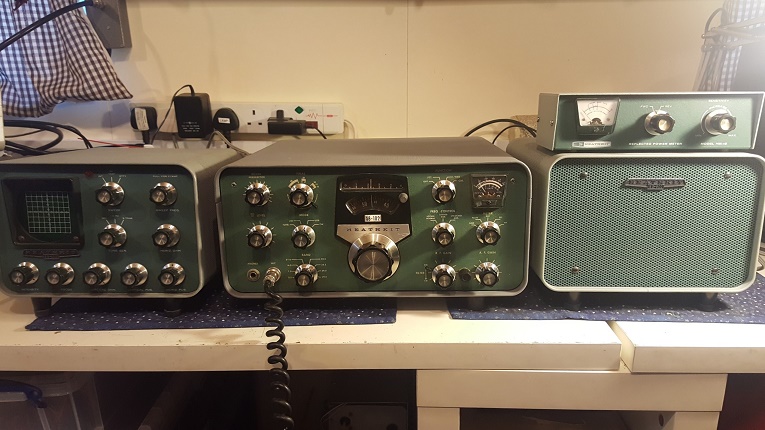
April 2017 Heathkit HW100
I got lucky again on eBay with this nearly 50
year old Heathkit. After vowing never to buy another HW or SB model,
this immaculate HW100 came up in the UK, the seller said it was in good
condition
but was faulty...I bid a low price...and won!. 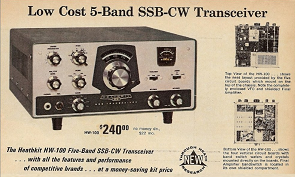
The seller was a dealer and must have tested the radio with the separately listed HP23 PSU (they wanted too much for that) and found it was dead. I fretted that although it looked good it would have bits missing and be a dog inside. On first inspection the cosmetic condition was simply staggering, looking almost like new..and all tubes, screws and parts were present. The build quality was pretty good and it had a few of the common mods added (but not brilliant soldering). My first test is always just the heaters - so I applied 12.6V and it looked OK, I then added -100V bias and 275V for the RX...nothing - just a nice hiss. On closer inspection I could see that 2 valves on the modulator / carrier board were out and stone cold. Looking at the detailed manual I was quickly able to trace a broken solder joint on the heater wiring between the boards..fixed that and it came to life straight away. Added 750V and got around 50W on 80m and had no trouble making contacts. Although the VFO dial is truly awful (better on the HW101) its rock stable if left alone. The PTT and VOX were a little erratic and this was cured by changing the relay driver 6EA8 tube (I only had a 6U8 / ECF82 but works fine). Found a few out of spec resistors and after a touch of alignment its back to 100W on 40 and 80m running from a KW Atlanta PSU..sounds great according to my chums
The HW100 grew out of Heathkits first SSB trasnceiver kit the SB100 (dubbed the 'poor mans Collins'!) in 1966. The SB or 'Sugar Baker' line was quickly added to and updated but Heath decided they needed a low cost version of the SB100 and came up with the HW 'Hot Water' 100. Both transceivers use similar PCBs but the HW has a cheaper VFO, VFO drive, chassis and fewer external connections...but underneath its pretty much the same radio. As the SB100 was updated to the 101 and 102, the Company did the same with their low cost line and brought out the HW101 in 1970. It had some component and valve /tube changes and a better dial drive and sold 30 - 40,000 units until the early 80s. Many hams across the world built them, learned about electronics and worked the world. One thing that really sets Heath apart from KW and Drake is the fantastic documentation - the manuals detail every aspect of the build and circuit description. Many are available online and there are lots of mods listed here
Heathkit HW101 (another 2 !) - April 2017
Suddenly
these things are coming out of the woodwork..Took delivery of 2 HW101
radios and finally a HP23 Heath Power Supply. I really only wanted the
PSU but took the radios as part of the lot. One was pretty poor with
loads of bodges, very scruffy, extremely dirty inside, broken VFO drive,
holes drilled in the front panel (my most un-favourite bodge), RIT
modification. It was really hard to clean it up..the front panel was so
bad I had to completely remove it and use a cream kitchen cleaner
to get the grime off. I really can't understand what posesses hams to
badly bodge radios, this picture is of the HW101 audio board, removed all
the added components and the radio works
prefectly..tell me folks - why do they do it?...and another thing, why
oh why cut down the skirt of the tuning knob and glue a useless
numbered dial to it ???
.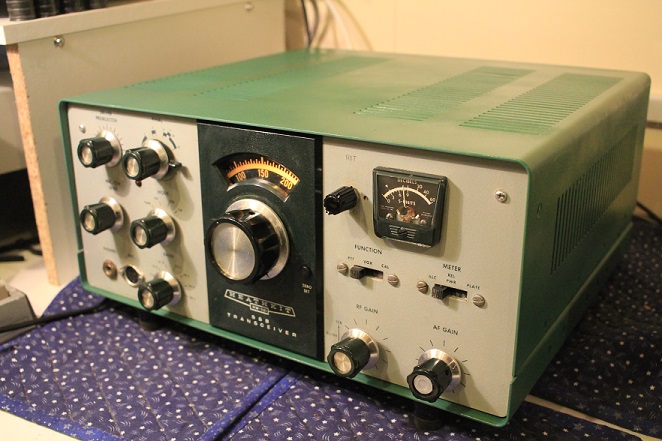
BEFORE AND AFTER PICS - HW101 number 1
The power supply connector also had a broken centre spigot which could be pretty dangerous if you connected up the PSU wrong..OUCH!...BUT I always like a challenge and after spending a day carefully removing the awful mods I applied power. The IF stages were clearly working and I could just hear the calibrate signal. I checked the first RF Amplifier HT voltages and found 0 volts on the screen - the 10K screen resistor had become an insulator. I quickly bridged it with another and the damn radio woke up. Getting to any components under the bandswitch is an absolute nightmare...easy to assemble but just awful to pull apart. I had to remove several bandswitch wafers and the screening plates to change the dodgy TX driver valveholder. I discovered my new one was a little taller than the original meaning the 6CL6 is almost touching the PA TUNE/LOAD shafts that run above it. I had some instability on 20m that was cured by putting the screening can on the 6CL6 and soldering the can to ground with stiff wire - the original builder did not bother.
I found a lot of other resistors that had either failed in the past or gone way out of spec, some HW and SB restorers in the USA have replaced nearly 40 resistors that were above 20% out of tolerance. This is a staggering number and way beyond any other make of radio I have worked on. I replaced the 11 pin chassis plug with the base of an old 11 pin relay..its the same size but square, so I mounted it inside the chassis and held it in with small screws. The original parts only seem to be available in the USA and with postage the cost quite is high..I used what was to hand. The outer Jackson VFO slow motion drive is available here in the UK and is a drop in replacement.
Looking in the PA compartment revealed that the neutralising capacitor connection was a dry joint - I just pulled it off. After another day of assessment and cleaning it was time to test the TX. With the original valves I got power straight away..it was then I discovered the balanced modulator was way out of alignment..50W of carrier!. I had to replace the carrier balance 200R preset pot and remove a 12pf cap from one side of the modulator to null the carrier..and even then its not brilliant. The diodes had been changed at some point and I will replace with BAT85 diodes. The last user had also put a trimmer acrosss the USB crystal to bring it closer to the filter passband. 100w out on 80, 40 and 20m and again loads of contacts. Most of the case screws were missing so I ordered a pack of the correct 6-32 ones from eBay -its the little things that make a radio look good. All 3 of my Heathkit HWs had dirt in the PA tune capacitor and arced on 80m at full power - cleaning between the vanes with a piece of card cured it.
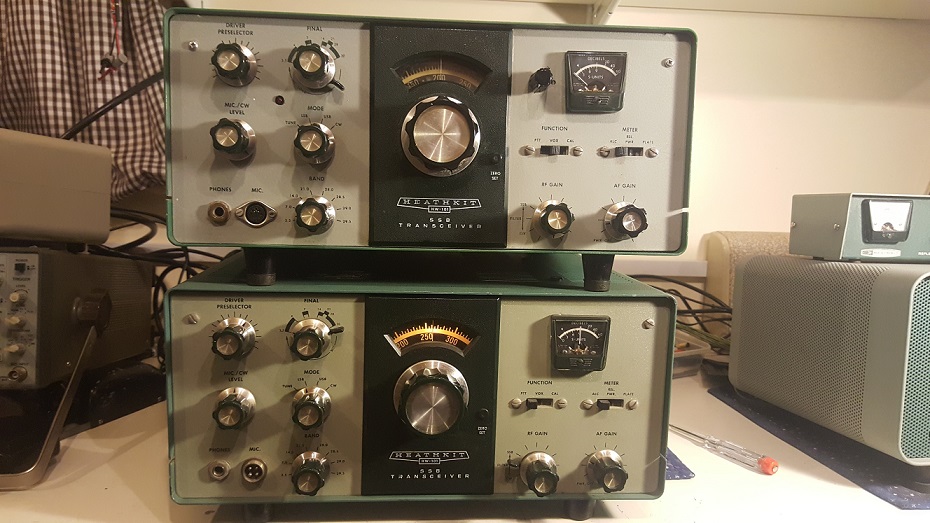 The 2nd
HW101 was much better with no bodges except an added
internal speaker..and no thick covering of dirt. They were 3 faults that
affected it. After a few minutes one of the HT dropper resistors went
O/C and stopped the OA2 voltage regulator working..so no volts on the
VFO. I changed it and all was well. The ECL86 AF output valve made some
very odd noises..and changing the tube cured it. I changed a few out of
spec resistors (often the same ones each time) and the drive belts and
was further surprised when near 100W came out on 20m 40m and 80m.
It always amuses me having contacts with old kit on 20m - so many hams have stations worth a
fortune..and there is me with a homemade vertical and a 50 year old radio.
After quite a lot of work both radios are working pretty well and have
had a cosmetic makeover
The 2nd
HW101 was much better with no bodges except an added
internal speaker..and no thick covering of dirt. They were 3 faults that
affected it. After a few minutes one of the HT dropper resistors went
O/C and stopped the OA2 voltage regulator working..so no volts on the
VFO. I changed it and all was well. The ECL86 AF output valve made some
very odd noises..and changing the tube cured it. I changed a few out of
spec resistors (often the same ones each time) and the drive belts and
was further surprised when near 100W came out on 20m 40m and 80m.
It always amuses me having contacts with old kit on 20m - so many hams have stations worth a
fortune..and there is me with a homemade vertical and a 50 year old radio.
After quite a lot of work both radios are working pretty well and have
had a cosmetic makeover
Heathkits are fun and when operating well are pretty good..but those damn resistors - some of them are very hard to get too. During a restoration be prepared for a battle with both the radio and its original builder. I would only consider restoring Heathkit valve ham kit if its a cheap purchase - the build and component quality is just too variable..you will have to work on them. The front end RF and first RX mixer valves on the 101 are the rare 6HS6, either or both can be substituted with a 6AU6 (used in the HW100). No component changes are required, its plug and play - you might lose a bit of gain on 15 and 10m. The 6HS6 was not developed until 1963 - which is very late - as a consequence they were not made in the huge quantities of the other bottles and now command a high price. The first RX mixer in one radio kept leaking away the AGC after the radio had been on a few minutes - a valve substitiuton cured it
There are a lot of mods listed on the web and I made one or two on all 3 Heathkits, rolling off the harsh treble of the receive audio was one I found very effective.
As with my other radios I decided to repaint the cabinet on the worst HW101, a trip to the shops showed that Ford 'Meadow Green' was a close match..and the process I use is always the same, rub down with wet/dry, 3 coats of primer and 3/4 light top coats
The HP 23B PSU was in pretty good condition - but the first task was to change out the elecctrolytic capacitors - I used modern 35mm diameter ones with plastic clips that match the screw holes of the old ones - its not worth buying a repair kit from the USA, all the parts are available cheaply. It even came with the rare 11 pin connectors and lead to the radio - now I can run any SB or HW gear without using my KW Atlanta PSU
Heathkit HW32A
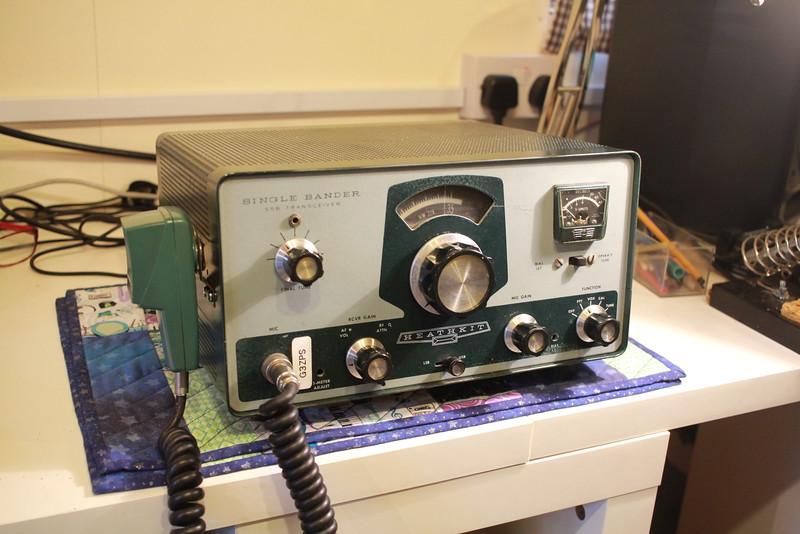
Next is a Heathkit HW32A 20m 'Single Bander' must be over 40 years old....a bit tatty when passed on to me for free - but what a difference a week makes!!. Took a few hours to clean it up and remove some bodged mods..may not have been switched on for decades. Lashed up a PSU in my workshop and checked for any short circuits...very little to go wrong all the front end tuning is preset as it only covers 150KHz of the band. I was amazed when the RX came up straight away. Next day decided to put the PA HT on..and another surprise - power out and OK audio. Called some EU stations on sporadic e on 20m and they came back!!.
New decent PCB valve holders took one day to put in, Heathkit used cheap ones that become very intermittent indeed - I'm not the only one to spot that this will drive you mad fixing an old Heathkit - just change them. I used a desolder suction tool and put in nice new ceramic bases, the PCB mounting ones are an identical fit.
Rubbed down the case and used my favoured Hammerite paint (they do a nice dark green), looks great and I love it. I'm not a huge fan of the much more complex HW101 and SB line but these are everything a kit should be - light, simple and fun - I want the 40m and 80m ones now!! I bought the Shure 201 at a Ham Rally early in 2016, and it looks the part here. Can't get the silly white sticker off without damaging the paint so stuck my call on it instead.
Don't buy expensive Heathkit 11 Pin PSU plugs from ebay in the Ham Radio section- the part that plugs into old Heathkit tube radios is actually cheap and easy to get - Its an international standard relay socket - here is a link - search for one of these on ebay. I made a further adaptor up which allows me to plug the HW into my KW Atlanta PSU.
After a further bit of research - I wonder if any HW22A 40m units ever made it to Europe?..The US models Cover 7.2 -7.3MHz. The 80m HW12A in the US covers 3.8 - 4.0MHz..so the UK 80m ones must have been modified to cover the EU part of 80m below 3.8MHz. The HW22A 40m variant (which would also have to be modified to cover the EU band at that time of 7.00 - 7.1MHz ) is not listed in any old UK magazine adverts
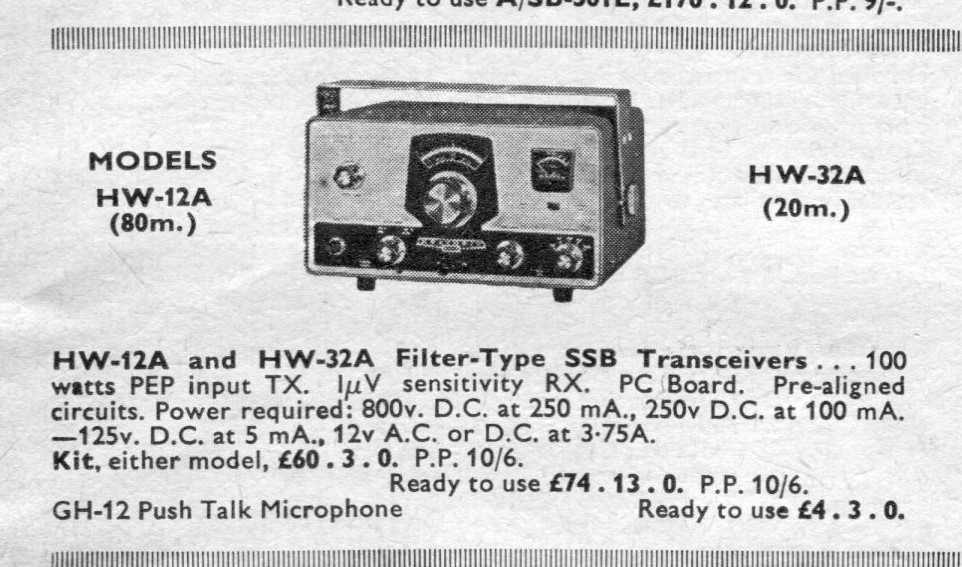
It seems possible that the 40m version was never modified by Heathkit for the EU and so never sold here. That would account for me never seeing one!!...so it looks like I'm only after an 80m one now...let me know. I have worked into the Saudi Arabia USA and Canada with this little radio.
Heathkit Receiver HR 1680 - December 2016
Got hold of this little solid state SSB receiver and matching speaker from a ham buddy. Very clean inside and out and working fine, its a nice example from 35 - 40 years ago. Its a proper dual conversion design with a very stable VFO, it has a 4 pole crystal SSB filter and is very quiet and sensitive even on 10m. A nice addition is a narrow audio filter for CW, although no CW IF filters is fitted. The only real let down is the audio derived AGC which can cause quite a lot of speech 'pops'. I love the simple and uncluttered plug in board design which use big connectors and appears bomb proof. I even have the extender boards which are rare...possibly the easiest bit of ham kit to service that I own. Pity that the dial numbers and gradations have worn away a little. I love it
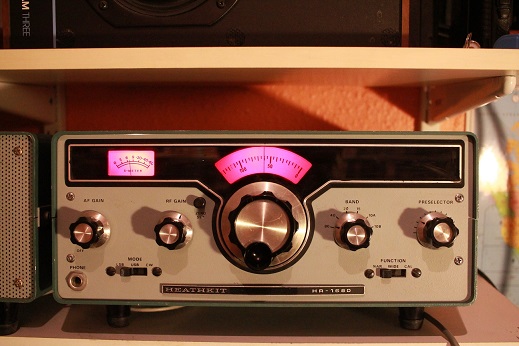
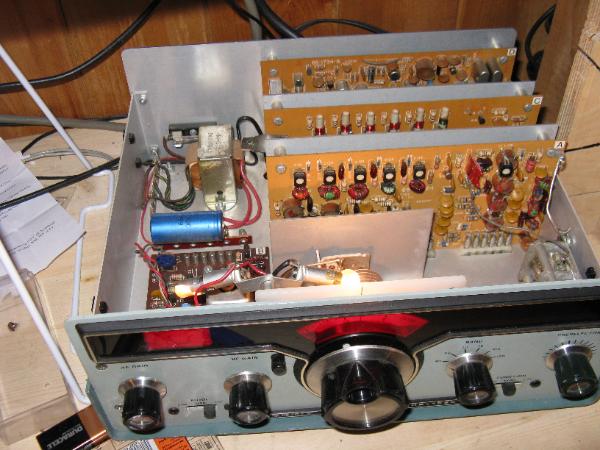
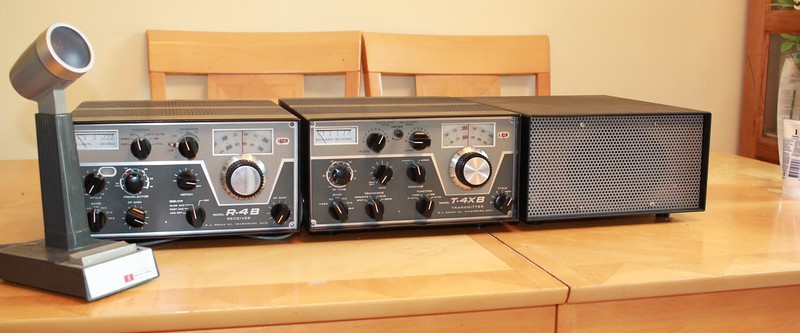
Connect with me today
Call me on 44 (0)7970 190437